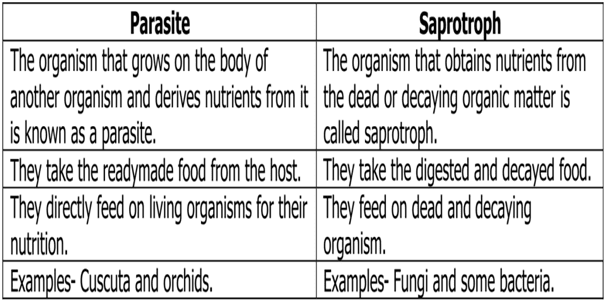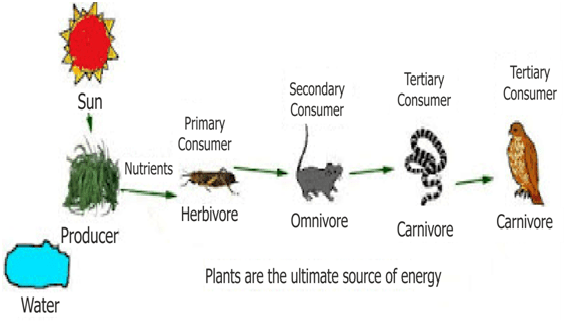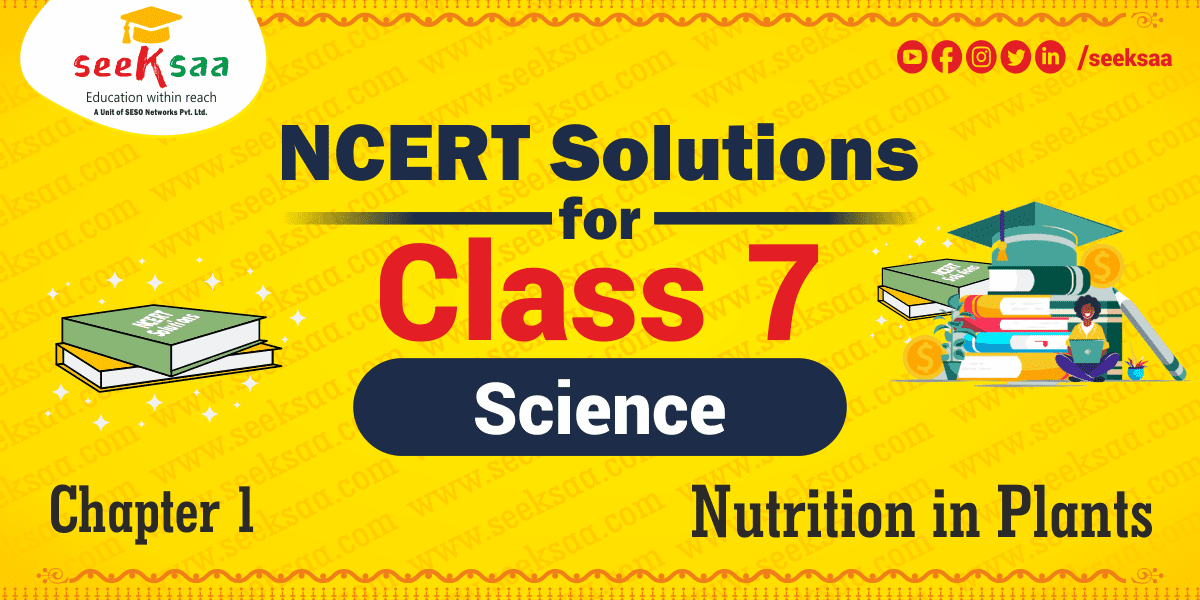Topics and Sub Topics in Class 7 Science Chapter 1 Nutrition in Plants:
| Section Name | Topic Name |
|---|---|
| 1 | Nutrition in Plants |
| 1.1 | Mode of Nutrition in Plants |
| 1.2 | Photosynthesis-Food Making Process in Plants |
| 1.3 | Other Mode of Nutrition in Plants |
| 1.4 | Saprotrophs |
| 1.5 | How Nutrients are Replenished in the Soil |
NCERT Solution of Class 7 Chapter-1 are :
Q 1- Why do organisms need to take food?
Ans- Organisms need to take food to get energy and perform life process. The life process include nutrition, respiration, growth, excretion, reproduction and response to stimuli which can only be done by intake of food.
Q 2-Distinguish between a parasite and a saprotroph.
Ans-

Q 3- How would you test the presence of starch in leaves?
Ans- Steps to test the presence of starch in leaves :
Step 1: A fresh leaf is taken.
Step 2: The leaf is boiled in water for few minutes to kill the cells in the leaf.
Step 3: Now, dip this leaf in iodine solution.
Step 4: The color of the leaf will changes into blue black color when iodine is added to it which shows the presence of starch in it.
Q 4- Give a brief description of the process of synthesis of food in green plants.
Ans- Photosynthesis is the process synthesis of food in the plants with the help of chlorophyll and carbon dioxide in the presence of sunlight.
Water and minerals present in the soil are absorbed by the roots and transported to the leaves by the vessels.
Carbon dioxide from air is taken through stomata present in leaves.
Leaves are the food factories of the plants which capture the energy of the sunlight with the help of chlorophyll. This energy is used to synthesize food from carbon dioxide and water.

Q 5- Show with the help of a sketch that the plants are the ultimate source of food.
Ans- The food chain shows that the plant is the ultimate producer. Only plant can produce food and rest of other organisms are directly or indirectly dependent on it.

Q 6- Fill in the blanks:
(a) Green plants are called ____________ since they synthesis their own food.
(b) The food synthesized by the plants is stored as _________________.
(c) In photosynthesis solar energy is captured by the pigment called ___________.
(d) During photosynthesis plants take in ___________ and release _____________.
Ans-
(a) Green plants are called autotrophs since they synthesize their own food.
(b) The food synthesized by the plants is stored as starch.
(c) In photosynthesis solar energy is captured by the pigment called chlorophyll .
(d) During photosynthesis plants take in carbon dioxide and release oxygen.
Q 7- Name the following:
(i) A parasitic plant with yellow, slender and tubular stem.
(ii) A plant that has both autotrophic and heterotrophic mode of nutrition.
(iii) The pores through which leaves exchange gases.
Ans-
(i) Cuscuta (Amarbel) (ii) Pitcher plant (iii) Stomata
Q 8- Tick the correct answer:
(a) Amarbel is an example of:
(i) autotroph (ii) parasite (iii) saprotroph (iv) host
Ans : (ii) parasite
(b) The plant which traps and feeds on insects is:
(i) Cuscuta (ii) china rose (iii) pitcher plant (iv) rose
Ans : (iii) pitcher plant
Q 9- Match the items given in Column I with those in Column II
Column I Column II
Chlorophyll Bacteria
Nitrogen Heterotrophs
Amarbel Pitcher Plant
Animals Leaf
Insects Parasite
Ans-
Column I Column II
Chlorophyll Leaf
Nitrogen Bacteria
Amarbel Parasite
Animals Heterotrophs
Insects Pitcher Plant
Q 10- Mark ‘T’ if the statement is true and ‘F’ if it is false:
(i) Carbon dioxide is released during photosynthesis. (T/F)
Ans : False
(ii) Plants which synthesis their food themselves are called saprotrophs. (T/F)
Ans : False
(iii) The product of photosynthesis is not a protein. (T/F)
Ans : True
(iv) Solar energy is converted into chemical energy during photosynthesis. (T/F)
Ans : True
Q 11- Choose the correct option from the following:
Which part of the plant takes in carbon dioxide from the air for photosynthesis?
(i) Root hair (ii) Stomata (iii) Leaf veins (iv) Sepals
Ans : (ii) Stomata
Q 12- Choose the correct option from the following:
Plants take carbon dioxide from the atmosphere mainly through their:
(i) roots
(ii) stem
(iii) flowers
(iv) leaves
Ans : (iv) leaves
NCERT Solutions for Class 9 Science Chapter 4 Structure of Atom
NCERT Solutions for Class 9 Science Chapter 4 Structure of Atom Topics and Sub Topics in Class 9 Science Chapter 4 Structure of Atom: Structure of Atom Charged Particles in Matter The Structure of an Atom How are Electrons Distributed in Different Orbits (Shells)? Valency Atomic Number and Mass Number
NCERT Solutions for Class 8 Science Chapter 6 Combustion and Flame
NCERT Solutions for Class 8 Science Chapter 6 Combustion and Flame Topics and Sub Topics in Class 8 Science Chapter 6 Materials combustion and flame: Section Name Topic Name 6 Materials combustion and flame 6.1 What is Combustion? 6.2 How Do We Control Fire? 6.3 Types of Combustion 6.4 Flame
NCERT Solutions for Class 8 Science Chapter 5
NCERT Solutions for Class 8 Science Chapter 5 Materials Coal and Petroleum Topics and Sub Topics in Class 8 Science Chapter 5 Materials Coal and Petroleum: Section Name Topic Name 5 Materials Coal and Petroleum 5.1 Coal 5.2 Petroleum 5.3 Natural Gas 5.4 Some Natural Resources are Limited Coal and



